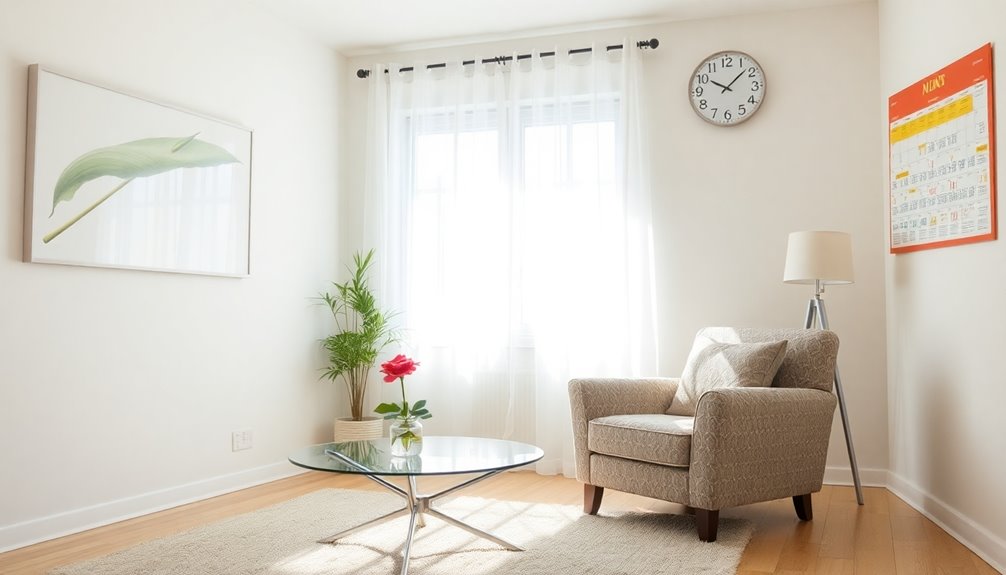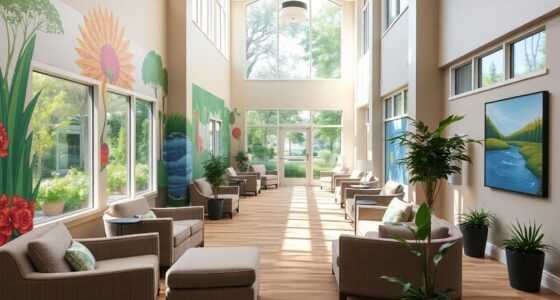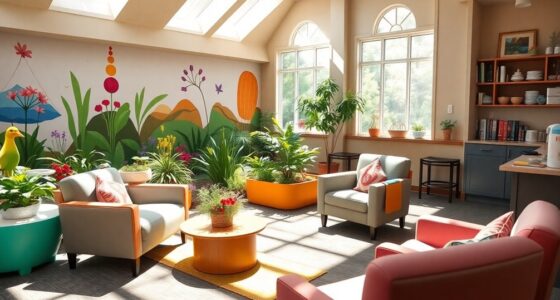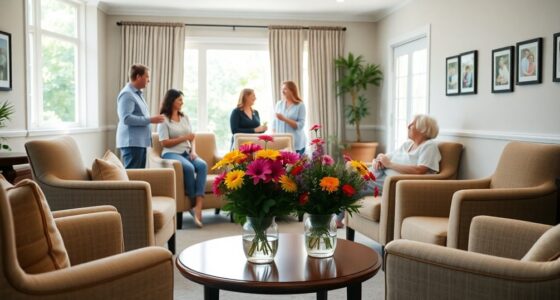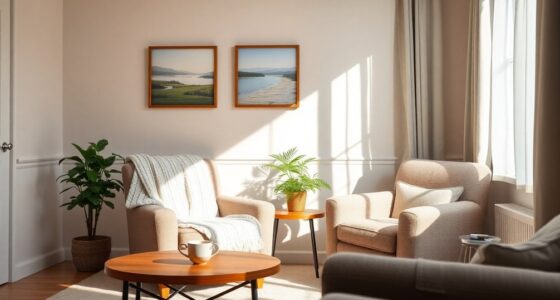To create a dementia-friendly home, prioritize adequate lighting by maximizing natural light and using automatic sensors. Utilize contrasting colors for furniture and signage to aid navigation. Simplify layouts and minimize clutter to guarantee clear pathways. Implement safety modifications, like grab bars and automatic stove shut-offs, to enhance security. Enhance signage with large fonts and familiar symbols. Finally, don't forget to create a comfortable outdoor space that's easy to access. Discover more helpful tips to optimize your home!
Key Takeaways
- Ensure adequate lighting throughout the home, incorporating natural light and automatic sensors for safe navigation day and night.
- Utilize contrasting colors for furniture and fixtures to enhance visibility and assist in navigation.
- Simplify layouts and minimize clutter to create clear pathways and reduce fall risks.
- Implement safety modifications like grab bars and automatic shut-off stoves to enhance overall well-being.
- Enhance signage with large fonts and familiar symbols to improve recognition and memory recall.
Prioritize Adequate Lighting
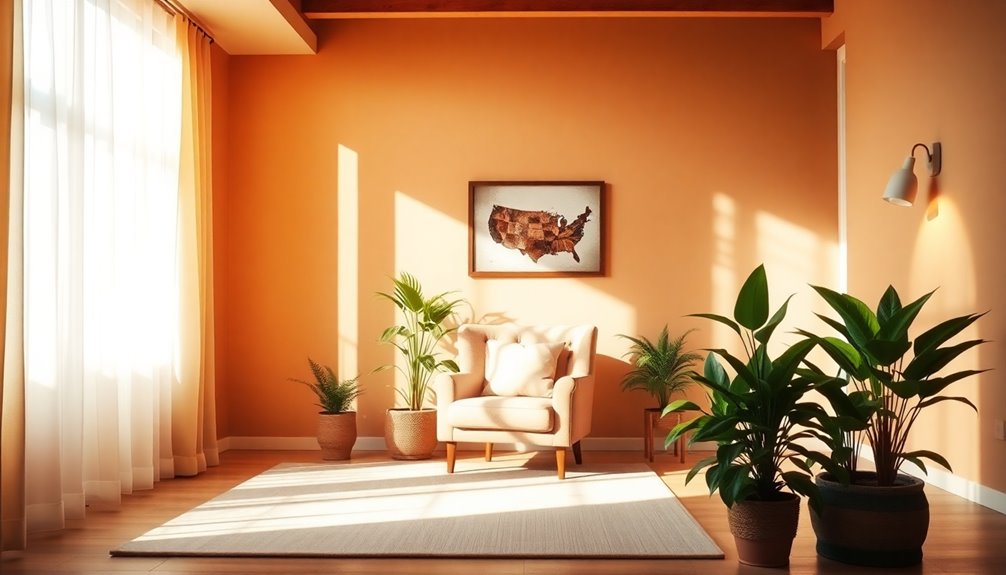
When you prioritize adequate lighting in a dementia-friendly home, you greatly enhance safety and comfort.
Establish lighting levels that are twice the recommended brightness to meet the visual needs of individuals with dementia, reducing confusion and minimizing fall risks. Incorporate natural light by keeping curtains open during the day; this supports circadian rhythms and improves sleep quality.
Choose home-style lighting options like table lamps and wall-mounted lights instead of harsh overhead lights to create a cozy atmosphere. Make certain your lighting aligns with the natural day-night cycle to signal bedtime and promote a sense of time.
Installing automatic light sensors in key areas offers convenient illumination, enhancing safety and ease of navigation throughout the home.
Utilize Contrasting Colors
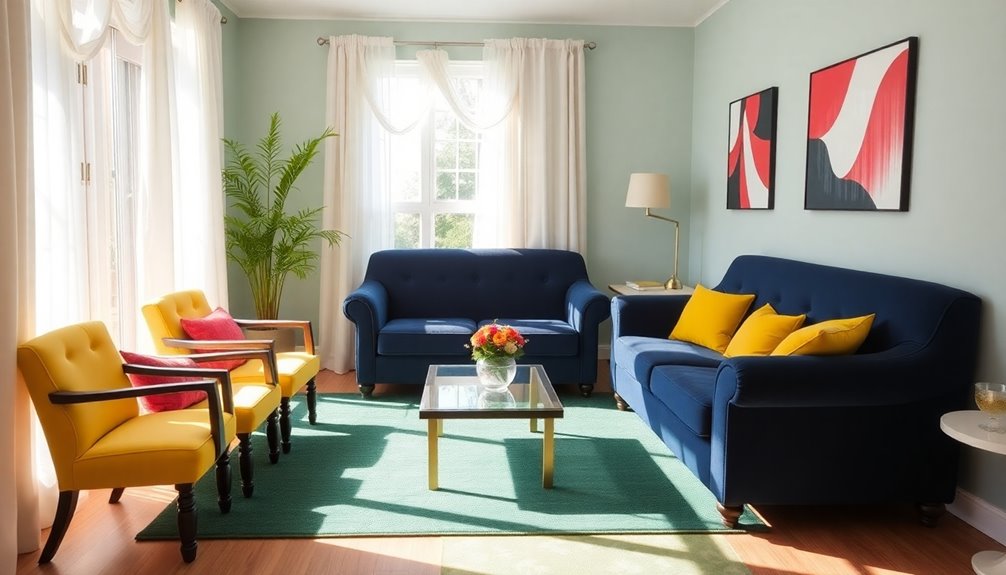
Utilizing contrasting colors in a dementia-friendly home not only enhances visibility but also aids navigation for individuals with cognitive impairments.
By selecting bold colors for furniture and furnishings against lighter backgrounds, you make it easier for them to identify and use these items.
Highlight doors and banisters with contrasting colors to promote safe movement and reduce confusion.
During mealtimes, choose crockery in contrasting colors, like white plates on green placemats, to define edges and enhance visibility.
Avoid bold patterns and stripes, as these can contribute to confusion; instead, stick to solid colors for a simpler visual experience.
Implementing these design choices will create a supportive environment that fosters independence and confidence.
Simplify Layouts and Minimize Clutter
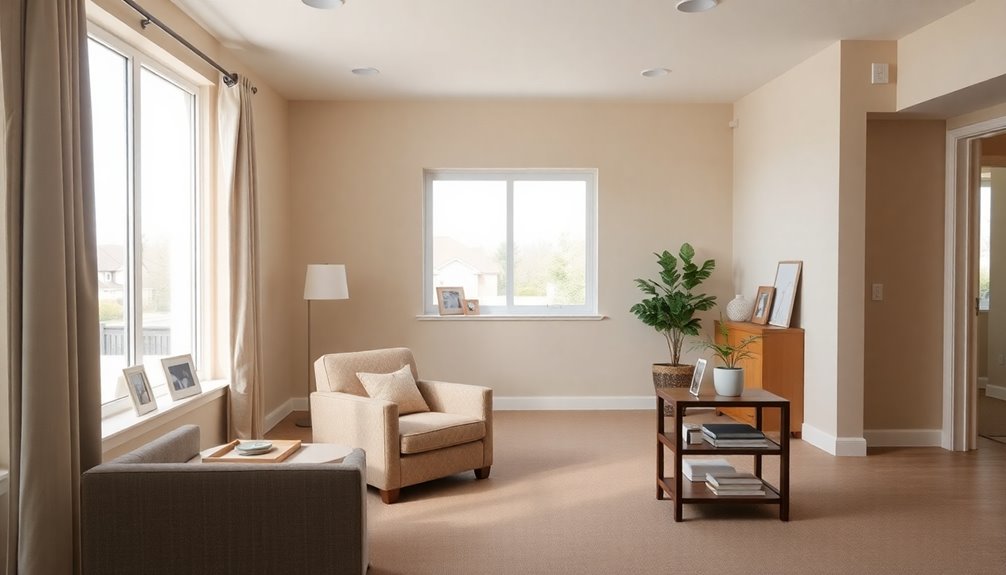
Creating a dementia-friendly home involves simplifying layouts and minimizing clutter to enhance safety and comfort. By simplifying layouts and ensuring clear pathways, you can help reduce confusion for your loved one.
Keep furniture to a minimum to foster an open environment, making it easier for them to navigate their home. To further promote independence, keep surfaces clear and clutter-free, minimizing the risk of falls.
Remove or tape down area rugs to eliminate tripping hazards. Store items in predictable locations, using clear labels or signs to aid recognition and retrieval.
A consistent arrangement of furniture and decor not only enhances comfort but also provides familiarity, making daily routines smoother and more manageable.
Implement Safety Modifications
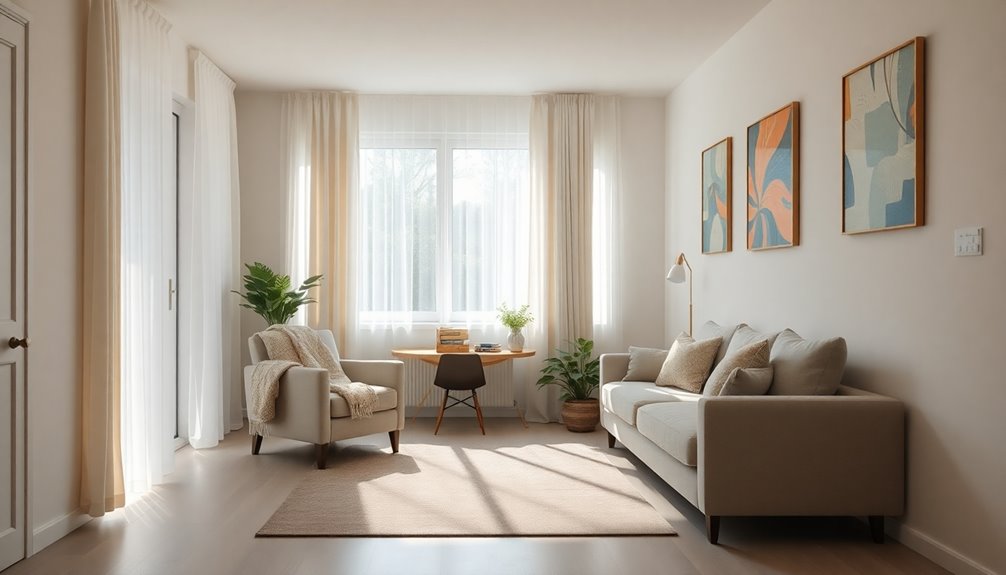
After simplifying layouts and minimizing clutter, it's time to focus on implementing safety modifications that can greatly enhance the well-being of someone living with dementia. These modifications can considerably improve visibility and aid in recognition. Here's a quick guide to essential safety upgrades:
| Safety Modification | Purpose | Benefits |
|---|---|---|
| Automatic shut-off stoves | Reduces fire risk | Prevents kitchen accidents |
| Bright contrasting colors | Enhances visibility | Aids in recognition of fixtures |
| Nightlights | Provides navigation at night | Prevents falls |
| Grab bars | Offers support in bathrooms | Reduces fall risk |
Incorporate Intuitive Design Elements
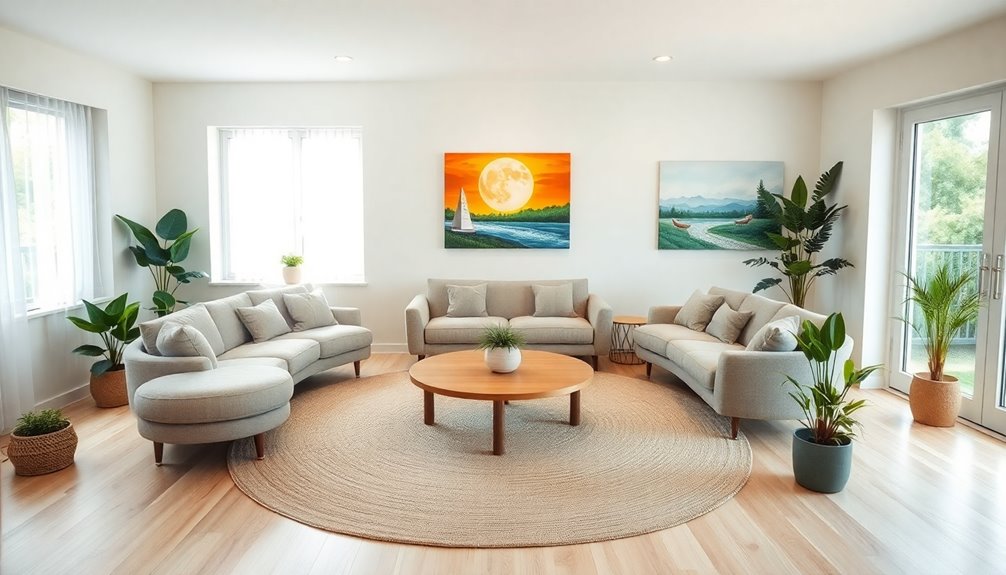
Incorporating intuitive design elements can greatly ease navigation for individuals with dementia, making their environment more familiar and accessible. By utilizing these strategies, you can create a supportive space:
- Clear signage: Use large, bold fonts and recognizable icons to help with orientation.
- Contrasting colors: Implement distinct colors on doors, walls, and furniture to enhance spatial awareness.
- Easily accessible locations: Store frequently used items where they're easy to find and label them clearly.
Additionally, maintain minimal clutter to simplify navigation, and let natural light flood the rooms.
Automated lighting systems can also adapt to the time of day, fostering a comfortable atmosphere that supports daily routines.
These elements contribute to a more dementia-friendly home.
Enhance Signage and Labels

To make guiding a home easier for individuals with dementia, enhancing signage and labels is essential. Use large, bold fonts and clear icons to improve visibility. Label drawers and cabinets with images or large print descriptions to assist in memory recall and reduce confusion. Color-coding rooms can provide visual cues that help identify spaces and their purposes.
| Signage Tips | Purpose |
|---|---|
| Use large, bold fonts | Improves visibility |
| Label with images | Assists memory recall |
| Color-code areas | Aids in space identification |
| Position at eye level | Enhances accessibility |
| Incorporate familiar symbols | Evokes positive memories |
These strategies create a dementia-friendly home, making it easier for loved ones to navigate their environment.
Create a Comfortable Outdoor Space

Creating a dementia-friendly home goes beyond indoor spaces; it extends to the outdoors as well. Designing comfortable outdoor spaces can enhance well-being and enjoyment of fresh air.
Focus on these elements:
- Comfortable seating: Choose accessible seating options that provide support and invite relaxation.
- Visual cues: Incorporate vibrant flowers and plants with contrasting colors to stimulate engagement and aid navigation.
- Safety features: Install non-slip pathways with clear borders to reduce confusion and guarantee a safe walking environment.
Additionally, create shaded relaxation areas with proper lighting and include familiar items that evoke positive memories.
Frequently Asked Questions
How to Design a Dementia Friendly Care Environment?
To design a dementia-friendly care environment, you should focus on creating a safe and comfortable space.
Use bright, even lighting to reduce confusion, and employ contrasting colors to enhance visibility.
Keep essential items organized and within reach, labeling rooms clearly.
Confirm safety modifications are in place, like removing tripping hazards and installing grab bars.
Finally, incorporate familiar elements, such as family photos, to evoke positive memories and foster a sense of belonging.
How to Design Homes for Seniors Living With Dementia?
When designing homes for seniors living with dementia, consider colorful contrasts. Bright, bold hues can enhance visibility, making spaces easier to navigate.
Cozy, comforting lighting creates a familiar feel, reducing confusion. Keep clutter to a minimum, storing essentials in predictable places, so they can maintain control.
Incorporate safety features like nightlights and grab bars to promote a secure environment. Thoughtfully designed spaces empower seniors, ensuring their independence and comfort.
What Are Three Ways to Make a Home Dementia Friendly?
To make a home dementia-friendly, start by enhancing lighting throughout your space, ensuring it's bright and evenly distributed to reduce confusion and fall risks.
Next, use contrasting colors for walls and everyday items to improve visibility and navigation.
Finally, keep your environment clutter-free by removing tripping hazards and unnecessary furnishings, creating a safer and more comfortable living space that supports independence.
These changes can greatly improve daily life and safety.
What Are the Three Golden Rules of Dementia?
Steering through dementia can feel like wandering through a foggy path, where clarity is hard to find.
The three golden rules of dementia guide your way: maintain a calm environment to lessen anxiety, encourage independence to boost confidence, and provide meaningful activities to enrich life.
Conclusion
By following these seven design tips, you can create a dementia-friendly home that truly makes a difference. Remember, a well-thought-out environment can help your loved ones feel more secure and comfortable. It's not just about aesthetics; it's about enhancing their quality of life. So, don't wait for the other shoe to drop—start implementing these changes today, and watch how a few thoughtful adjustments can lead to a happier, more supportive living space for everyone.
